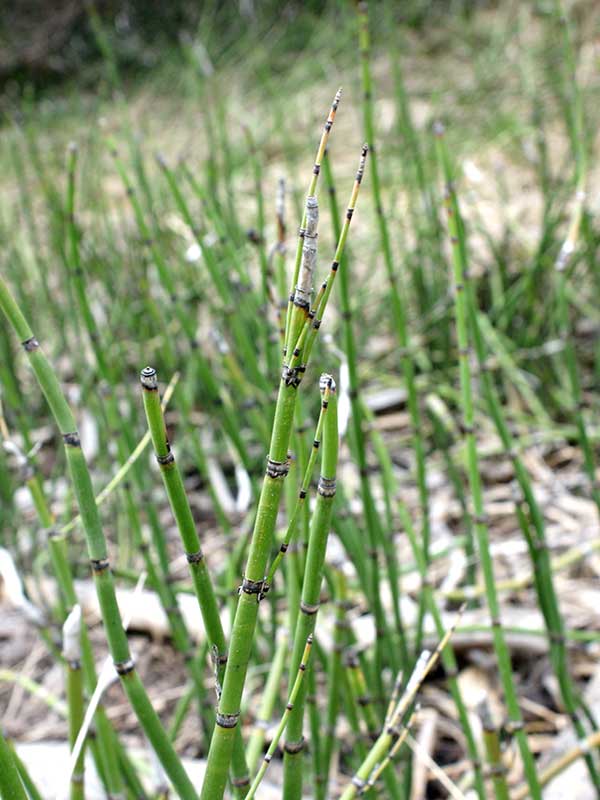Equisetum hyemale / rough horsetail
- thin green stems with black bands; no branches
- possible cone-like structure at the apex
- usually in large colonies
- prefers continuously moist soils
Also known as: scouring rush, scouringrush horsetail
See also: Equisetum arvense / field horsetail
Rough horsetail is a not-visibly-leafed perennial primarily found in wetlands of various sorts and riparian zones, springs and seeps. Unlike field horsetail, it is adapted to seasonal flooding, and not adapted to dry conditions. It forms dense, spreading colonies in full or partial sun.
Rough horsetail is characterized by having upright, jointed, reed-like stalks. The stems are ringed with thin black bands at the nodes. These are actually tiny leaves fused at their bases and clasping the stem. The stems are not branched (unless damaged). This is one sure way to distinguish it from E. arvense / field horsetail.
Like other horsetails, ferns and fern-allies, this species reproduces by spores produce in a cone-like structure (strobilus) at the tip of the stems. Unlike the field horsetail, the vegetative and fertile stems look the same except for that tip thing.
Like other horsetails, rough horsetail grows from rhizomes which have a very high capacity to spread. As illustrated in the gallery, clones can be quite large. Indeed, the capacity to form these clones makes this a highly invasive species if you were to, say, plant it in your garden.
Interesting bits – Equisetums are sometimes called scouring rushes or horsetail ferns. Neither is correct. Rather, Equisetum is the single surviving genus of a class of plants dating back more than 350 million years. They are called “primitive” not just because of their age, but because of the structure of their vascular and “root” systems. However, like ferns, they are non-flowering, and they reproduce by spores rather than seeds. Hence, they are called “fern allies”.
Nevertheless, the “rough” part is correct. Rough horsetail, or scouring rush, has been used to scour or clean pots. It has also been used as sandpaper. For some reed instrument players (e.g. clarinet, sax, oboe or bassoon players), it has been the tool of choice for putting the final touches on new reeds.
Equisetums of various sorts are quite penetrating if they find themselves under hard substrates. For example, I have seen them growing up through asphalt sidewalks in Scotland.
The spores of rough horsetail are green and photosynthetic. They can withstand profound desiccation but not for longer than two weeks.
Finally, this particular horsetail species is a favorite of homeopaths and despite it’s highly invasive nature, is very popular with garden stores as well. In fact, probably 90%+ of all the web search links are for one or the other (or both) of these.
| Family | |
|---|---|
| When? | |
| Where? | riparian, seeps, vernally wet areas, wet(ter) meadows, wetlands |

